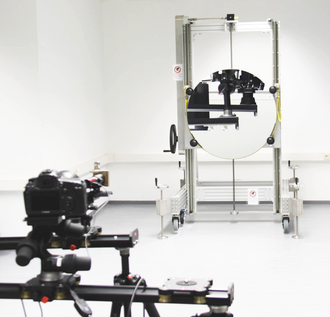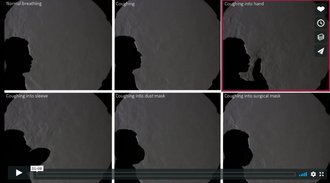The silhouette of a man is shown, first breathing normally and then beginning to cough heavily. He is first shown without anything covering his mouth. He then uses his hand, the crook of his elbow, and various types of masks. »When coughing without covering the mouth, it is especially clear how easily the air we breathe can permeate a room«, explains Prof. Conrad Völker, Department of Building Physics. For this reason, it is essential to cover your mouth when coughing according to the experiment. »The best method is to cover your mouth with the crook of your arm and to keep your hands clean to avoid spreading viruses and other pathogens via body contact or surfaces«, adds Prof. Völker. The use of respiratory masks also shows an improvement in slowing the spread. Besides that, respiratory masks filter aerosols transporting viruses, but there is no 100% effective method to prevent droplet infection.
News
Keep your distance: A new video from the Bauhaus-Universität Weimar illustrates how germs can spread through the air.
What happens when you cough? With the help of a so-called Schlieren mirror, researchers in the Building Physics department make visible what is normally hidden from the naked eye: Air currents in a room. The short film impressively shows why we should follow the World Health Organization’s (WHO) recommendations on how to prevent the spread of the coronavirus.
Abstand halten! – Wie sich Atemluft beim Husten verbreitet. Ein Experiment der Professur Bauphysik.

Abstand halten! – Wie sich Atemluft beim Husten verbreitet. Ein Experiment der Professur Bauphysik.
Click the Play button to load and view external content from Vimeo.com.
Automatically load and view external content from Vimeo.com (You can change this setting at any time via our »Data protection policy«.)
The Schlieren method for the visualization of indoor airflow
M. Sc. Amayu Wakoya Gena, DAAD-scholar in Building Physics at the Bauhaus-Universität Weimar, led the experiment, which was carried out for the current situation. Within his doctoral thesis, he uses the so-called Schlieren method, which helps visualize and measure indoor airflow. The centrepiece of the measuring device is a concave and highly polished mirror with a diameter of about one metre. With the help of this Schlieren mirror, even the smallest air currents are visible. »The principle is similar to when a road overheats in summer and the air above the asphalt shimmers«, explains Prof. Völker. Just like the air above the asphalt, warm, moist air that we breathe has a different density than the cooler air in the room. This difference in density leads to a deflection of light, which then appears as dark spots in a photo or video. These density differences, however, are extremely small in indoor airflows. They cannot be seen with the naked eye, but the Schlieren mirror allows them to be seen.
There are currently only four large Schlieren systems in the world. Each one is used in a different research field. In Weimar, the focus is on building physics measurements. At the Bauhaus-Universität Weimar, the large Schlieren system is used primarily to investigate indoor airflow and determine the influence of indoor climate on the human body. The goal is to develop individual solutions that optimise the energy efficiency of rooms. In 2017, researchers at the Bauhaus-Universität Weimar were the recipients of the award for »Deutschland - Land der Ideen« competition. The state of Thuringia provided around 400,000 euros to fund the Schlieren mirror. The project was co-financed by European Union funds through the European Regional Development Fund (ERDF).
The video can be viewed here:
vimeo.com/399120258
Contact:
Prof. Dr.-Ing. Conrad Völker
Bauhaus-Universität Weimar
Professorship of Building Physics
Phone: +49 (0) 36 43 / 58 47 01
E-mail: conrad.voelker[at]uni-weimar.de
Nachtrag vom 6.April 2020
In Anbetracht der aktuellen Debatte um den Gebrauch eines Mundschutzes weisen wir ausdrücklich darauf hin: Das Experiment wurde mit einer Staubschutzmaske und einer einfachen OP-Maske bzw. chirurgischen Maske durchgeführt. Zu sehen sind Visualisierungen von Raumluftströmungen, d.h. es können auf Basis des Videos keine medizinischen Aussagen bezüglich der Wirksamkeit eines Maskenschutzes getroffen werden. Ob und wie Tröpfchen durch das Material diffundieren muss in weiteren Untersuchungen getestet werden. Unsere Experten stehen diesbezüglich bereits in Kontakt mit Medizinern. Es ist jedoch nicht absehbar, wann verlässliche quantitative Daten zu erwarten sind.








